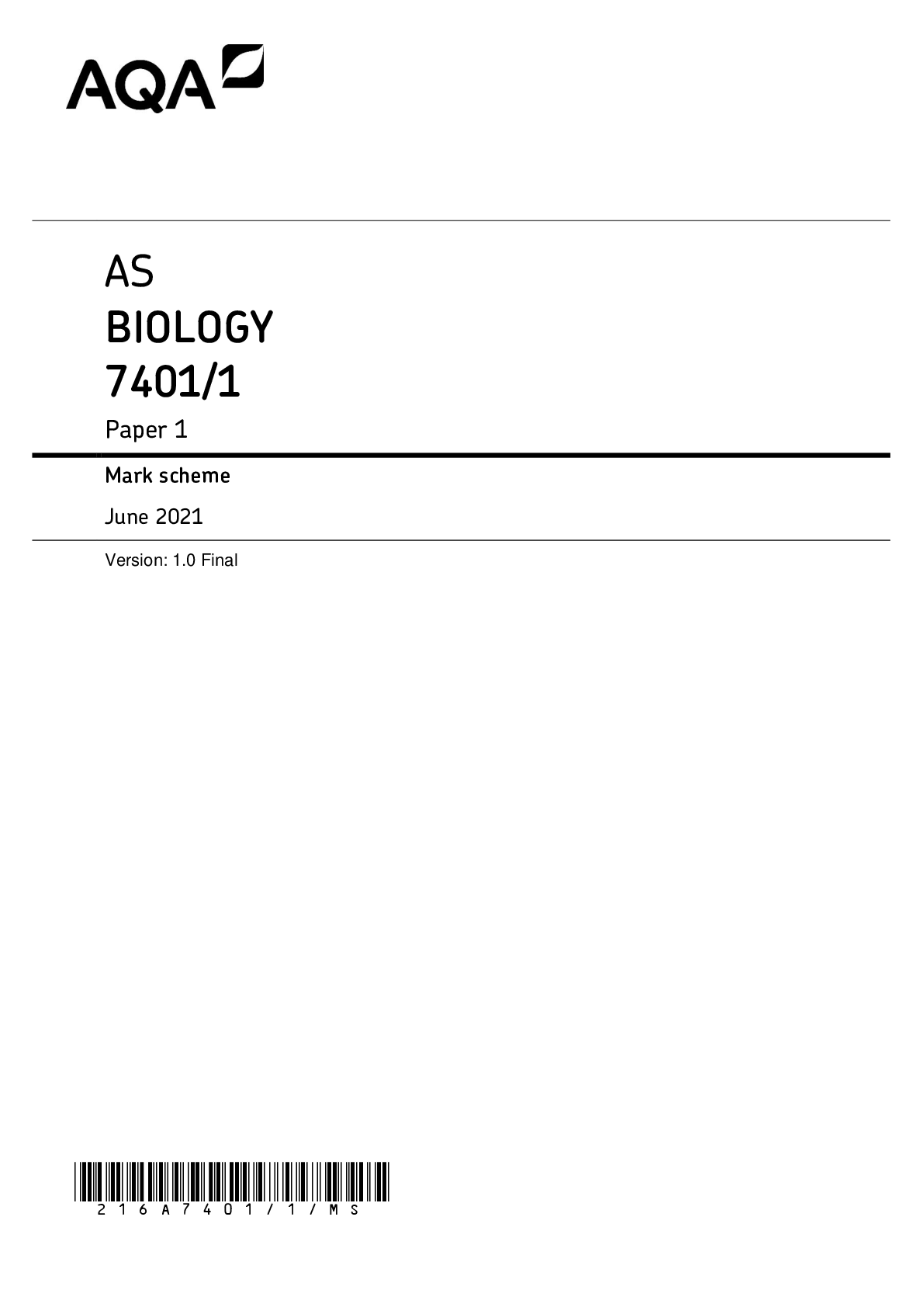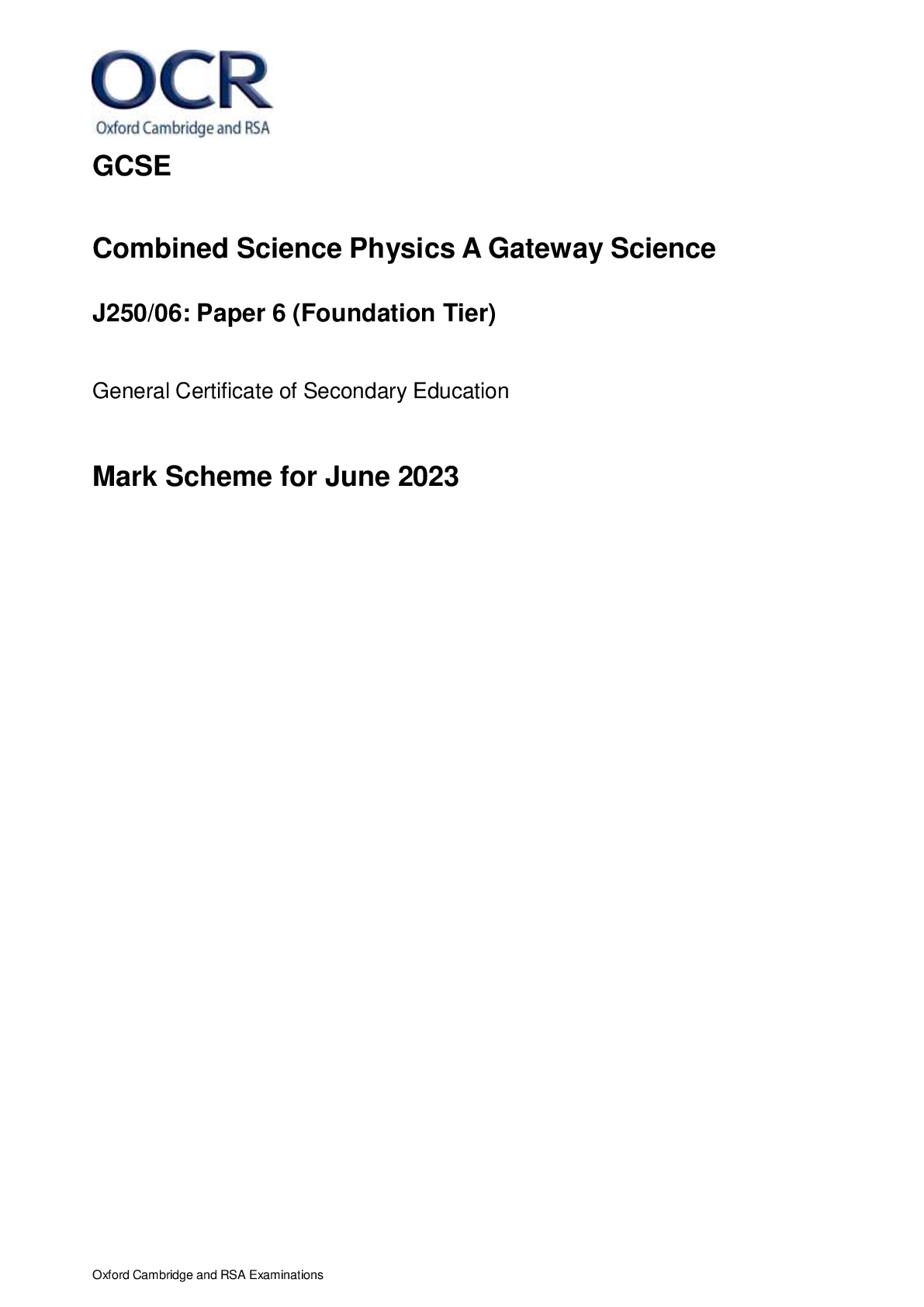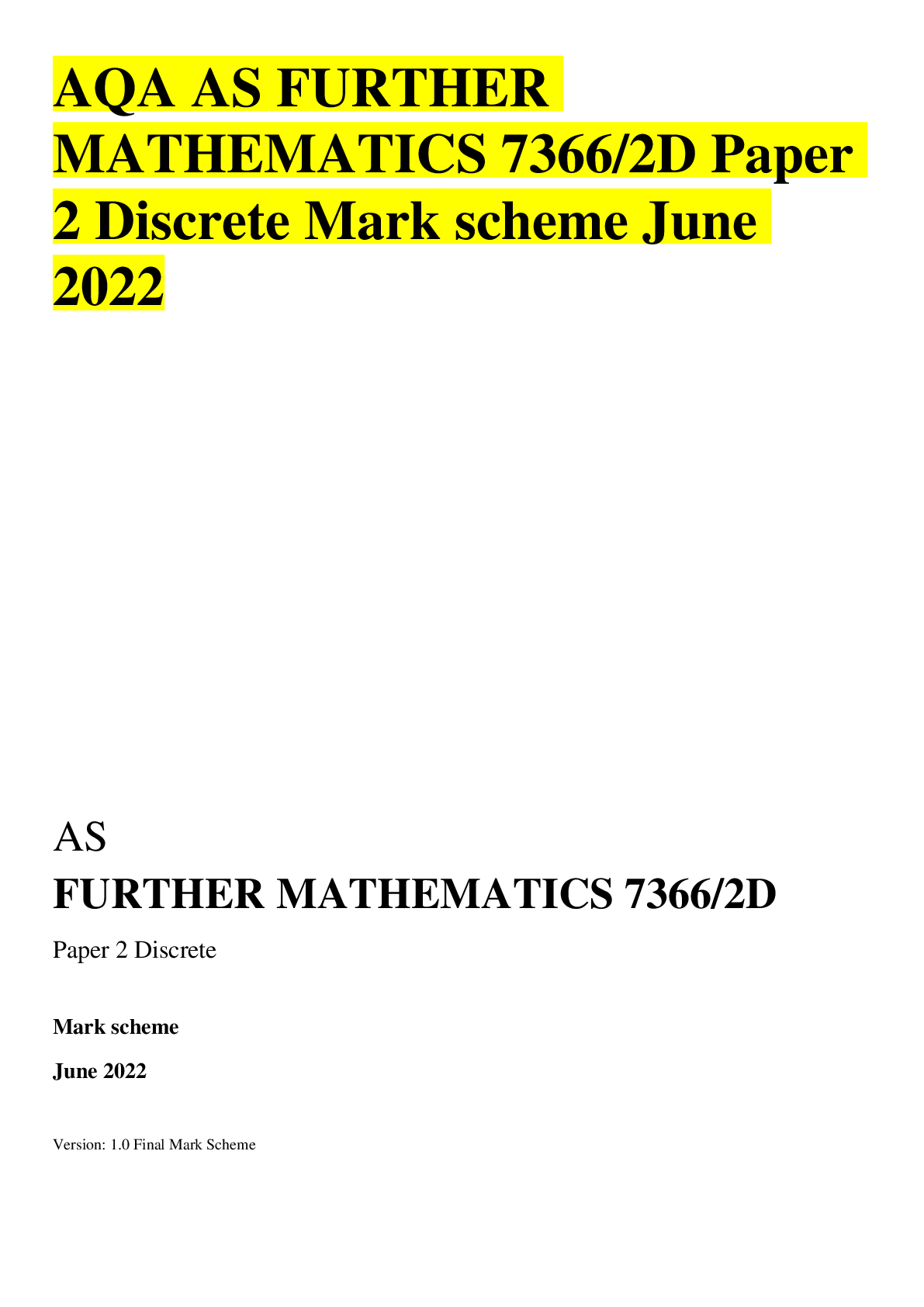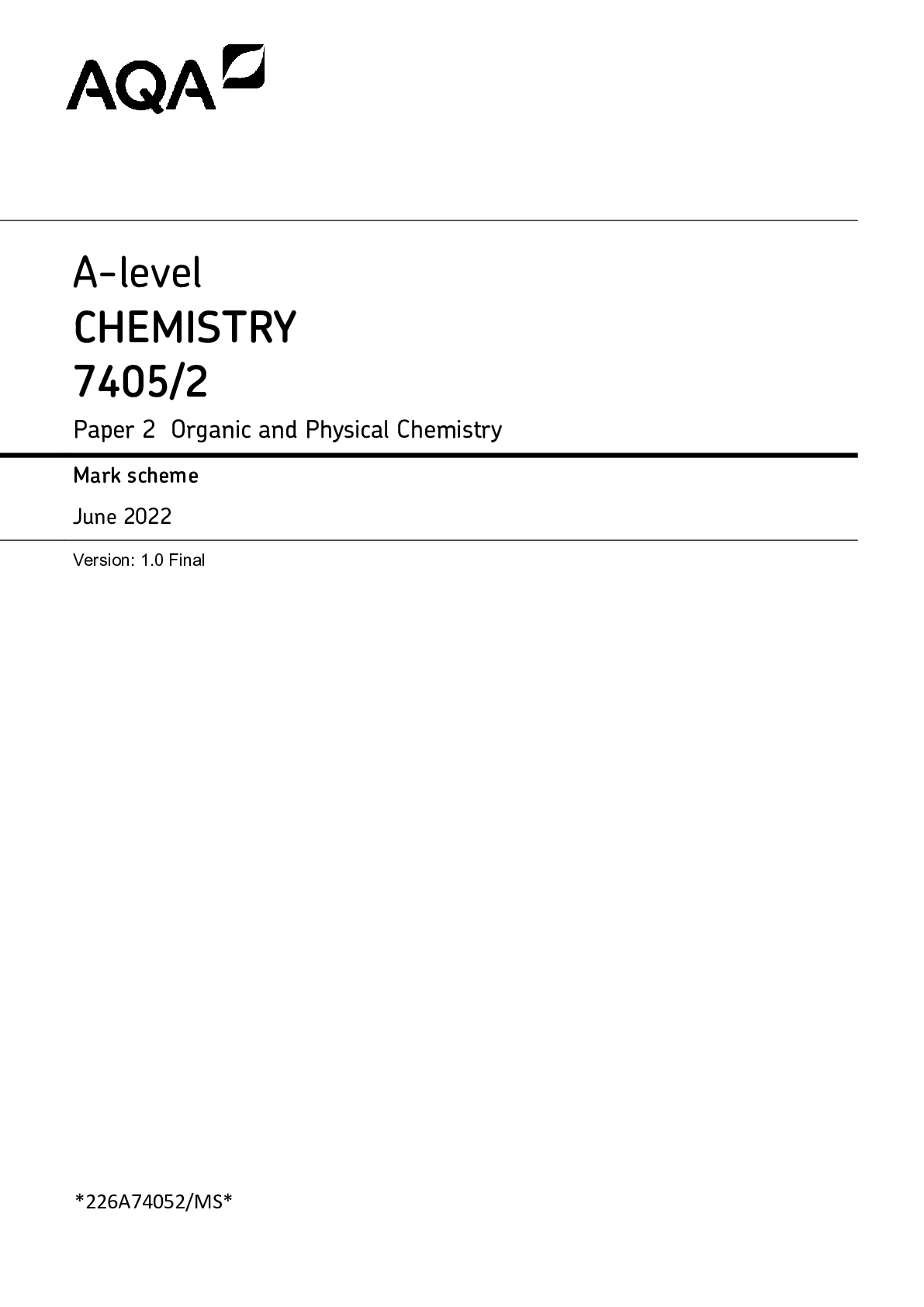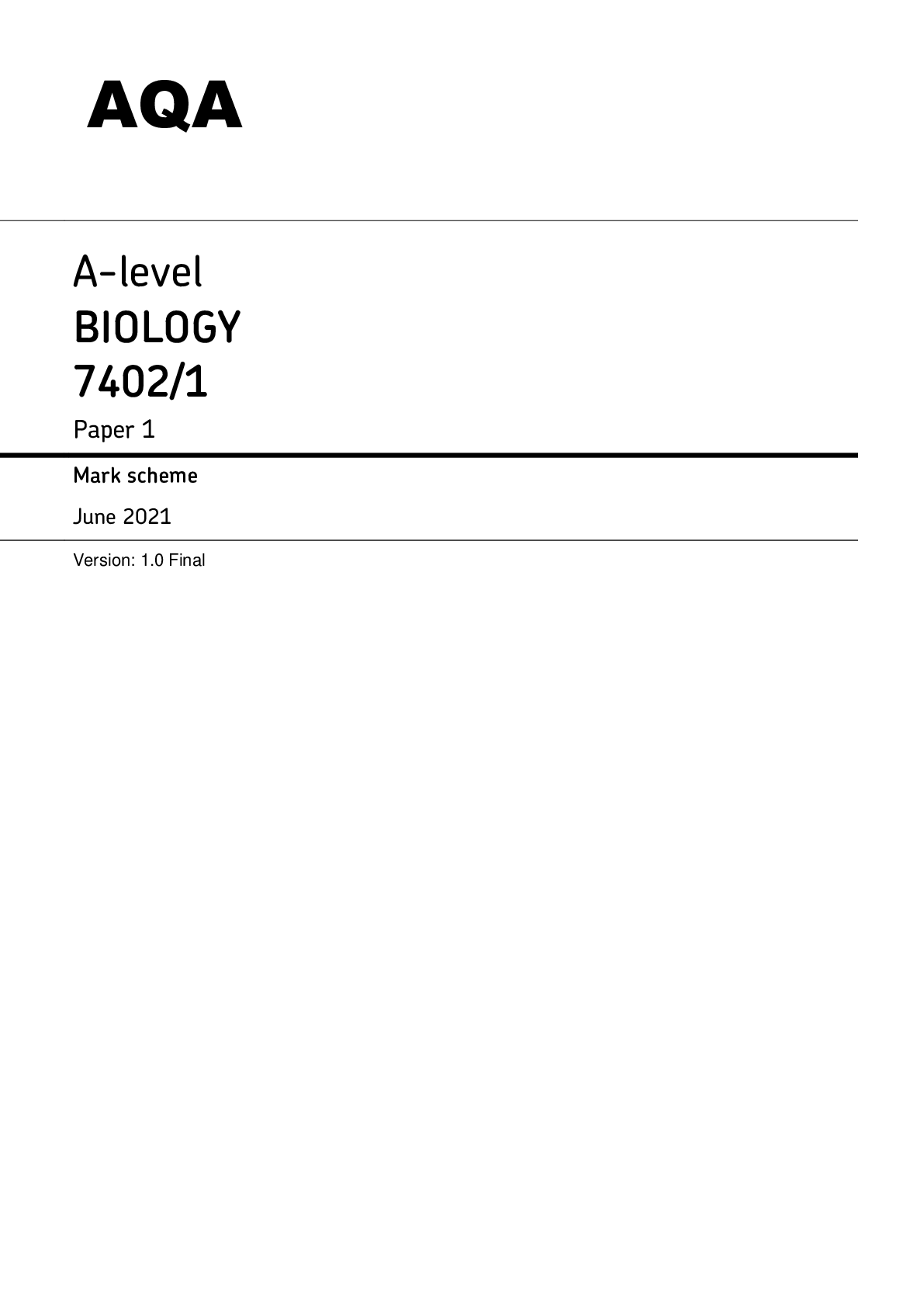AQA > A/As Level Mark Scheme > GCSE BIOLOGY 8461/1H Paper 1 Higher Tier Mark scheme June 2022 Version: 1.0 Final Mark Scheme (All)
GCSE BIOLOGY 8461/1H Paper 1 Higher Tier Mark scheme June 2022 Version: 1.0 Final Mark Scheme
Document Content and Description Below
GCSE BIOLOGY 8461/1H Paper 1 Higher Tier Mark scheme June 2022 Version: 1.0 Final Mark Scheme *226G84611H/MS* MARK SCHEME – GCSE BIOLOGY – 8461/1H – JUNE 2022 2 Mark schemes are prepa... red by the Lead Assessment Writer and considered, together with the relevant questions, by a panel of subject teachers. This mark scheme includes any amendments made at the standardisation events which all associates participate in and is the scheme which was used by them in this examination. The standardisation process ensures that the mark scheme covers the students’ responses to questions and that every associate understands and applies it in the same correct way. As preparation for standardisation each associate analyses a number of students’ scripts. Alternative answers not already covered by the mark scheme are discussed and legislated for. If, after the standardisation process, associates encounter unusual answers which have not been raised they are required to refer these to the Lead Examiner. It must be stressed that a mark scheme is a working document, in many cases further developed and expanded on the basis of students’ reactions to a particular paper. Assumptions about future mark schemes on the basis of one year’s document should be avoided; whilst the guiding principles of assessment remain constant, details will change, depending on the content of a particular examination paper. Further copies of this mark scheme are available from aqa.org.uk Copyright information AQA retains the copyright on all its publications. However, registered schools/colleges for AQA are permitted to copy material from this booklet for their own internal use, with the following important exception: AQA cannot give permission to schools/colleges to photocopy any material that is acknowledged to a third party even for internal use within the centre.. Copyright © 2022 AQA and its licensors. All rights reserved. MARK SCHEME – GCSE BIOLOGY – 8461/1H – JUNE 2022 3 Information to Examiners 1. General The mark scheme for each question shows: • the marks available for each part of the question • the total marks available for the question • the typical answer or answers which are expected • extra information to help the examiner make their judgement • the Assessment Objectives and specification content that each question is intended to cover. The extra information is aligned to the appropriate answer in the left-hand part of the mark scheme and should only be applied to that item in the mark scheme. At the beginning of a part of a question a reminder may be given, for example: where consequential marking needs to be considered in a calculation; or the answer may be on the diagram or at a different place on the script. In general the right-hand side of the mark scheme is there to provide those extra details which confuse the main part of the mark scheme yet may be helpful in ensuring that marking is straightforward and consistent (for example, a scientifically correct answer that could not reasonably be expected from a student’s knowledge of the specification).. 2. Emboldening and underlining 2.1 In a list of acceptable answers where more than one mark is available ‘any two from’ is used, with the number of marks emboldened. Each of the following bullet points is a potential mark. 2.2 A bold and is used to indicate that both parts of the answer are required to award the mark. 2.3 Alternative answers acceptable for a mark are indicated by the use of or. Alternative words in the mark scheme are shown by a solidus eg allow smooth / free movement. 2.4 Any wording that is underlined is essential for the marking point to be awarded. MARK SCHEME – GCSE BIOLOGY – 8461/1H – JUNE 2022 4 3. Marking points 3.1 Marking of lists This applies to questions requiring a set number of responses, but for which students have provided extra responses. The general principle to be followed in such a situation is that ‘right + wrong = wrong’. Each error / contradiction negates each correct response. So, if the number of errors / contradictions equals or exceeds the number of marks available for the question, no marks can be awarded. However, responses considered to be neutral (indicated as * in example 1) are not penalised. Example 1: What is the pH of an acidic solution? [1 mark] Student Response Marks awarded 1 green, 5 0 2 red*, 5 1 3 red*, 8 0 Example 2: Name two magnetic materials. [2 marks] Student Response Marks awarded 1 iron, steel, tin 1 2 cobalt, nickel, nail* 2 3.2 Use of symbols / formulae If a student writes a chemical symbol / formula instead of a required chemical name, or uses symbols to denote quantities in a physics equation, full credit can be given if the symbol / formula is correct and if, in the context of the question, such action is appropriate. 3.3 Marking procedure for calculations Marks should be awarded for each stage of the calculation completed correctly, as students are instructed to show their working. At any point in a calculation students may omit steps from their working. If a subsequent step is given correctly, the relevant marks may be awarded. Full marks are not awarded for a correct final answer from incorrect working. 3.4 Interpretation of ‘it’ Answers using the word ‘it’ should be given credit only if it is clear that the ‘it’ refers to the correct subject. MARK SCHEME – GCSE BIOLOGY – 8461/1H – JUNE 2022 5 3.5 Errors carried forward An error can be carried forward from one question part to the next and is shown by the abbreviation ‘ecf’. Within an individual question part, an incorrect value in one step of a calculation does not prevent all of the subsequent marks being awarded. 3.6 Phonetic spelling Marks should be awarded if spelling is not correct but the intention is clear, unless there is a possible confusion with another technical term. 3.7 Brackets (…..) are used to indicate information which is not essential for the mark to be awarded but is included to help the examiner identify the sense of the answer required. 3.8 Allow In the mark scheme additional information, ‘allow’ is used to indicate creditworthy alternative answers. 3.9 Ignore Ignore is used when the information given is irrelevant to the question or not enough to gain the marking point. Any further correct amplification could gain the marking point. 3.10 Do not accept Do not accept means that this is a wrong answer which, even if the correct answer is given as well, will still mean that the mark is not awarded. 3.11 Numbered answer lines Numbered lines on the question paper are intended to support the student to give the correct number of responses. The answer should still be marked as a whole. 4. Level of response marking instructions Extended response questions are marked on level of response mark schemes. • Level of response mark schemes are broken down into levels, each of which has a descriptor. • The descriptor for the level shows the average performance for the level. • There are two marks in each level. Before you apply the mark scheme to a student’s answer, read through the answer and, if necessary, annotate it (as instructed) to show the qualities that are being looked for. You can then apply the mark scheme. MARK SCHEME – GCSE BIOLOGY – 8461/1H – JUNE 2022 6 Step 1: Determine a level Start at the lowest level of the mark scheme and use it as a ladder to see whether the answer meets the descriptor for that level. The descriptor for the level indicates the different qualities that might be seen in the student’s answer for that level. If it meets the lowest level then go to the next one and decide if it meets this level, and so on, until you have a match between the level descriptor and the answer. With practice and familiarity you will find that for better answers you will be able to quickly skip through the lower levels of the mark scheme. When assigning a level you should look at the overall quality of the answer. Do not look to penalise small and specific parts of the answer where the student has not performed quite as well as the rest. If the answer covers different aspects of different levels of the mark scheme you should use a best fit approach for defining the level. Use the variability of the response to help decide the mark within the level, ie if the response is predominantly level 2 with a small amount of level 3 material it would be placed in level 2 but be awarded a mark near the top of the level because of the level 3 content. Step 2: Determine a mark Once you have assigned a level you need to decide on the mark. The descriptors on how to allocate marks can help with this. The exemplar materials used during standardisation will help. There will be an answer in the standardising materials which will correspond with each level of the mark scheme. This answer will have been awarded a mark by the Lead Examiner. You can compare the student’s answer with the example to determine if it is the same standard, better or worse than the example. You can then use this to allocate a mark for the answer based on the Lead Examiner’s mark on the example. You may well need to read back through the answer as you apply the mark scheme to clarify points and assure yourself that the level and the mark are appropriate. Indicative content in the mark scheme is provided as a guide for examiners. It is not intended to be exhaustive and you must credit other valid points. Students do not have to cover all of the points mentioned in the indicative content to reach the highest level of the mark scheme. You should ignore any irrelevant points made. However, full marks can be awarded only if there are no incorrect statements that contradict a correct response. An answer which contains nothing of relevance to the question must be awarded no marks. MARK SCHEME – GCSE BIOLOGY – 8461/1H – JUNE 2022 7 Question 1 Question Answers Extra information Mark AO / Spec. Ref. 01.1 nucleus (site of aerobic) respiration (cell) membrane must be in this order allow chromosomes allow plasmid allow makes ATP or releases energy do not accept produces / makes / creates energy do not accept anaerobic respiration 1 1 1 AO1 4.1.1.1 4.1.1.2 Question Answers Extra information Mark AO / Spec. Ref. 01.2 photosynthesis allow produce glucose / sugar allow to absorb (sun) light ignore contains chlorophyll 1 AO1 4.1.1.2 4.4.1.1 Question Answers Extra information Mark AO / Spec. Ref. 01.3 root (hair) allow xylem / phloem / epidermis / meristem 1 AO1 4.1.1.3 4.2.3.1 4.2.3.2 Question Answers Extra information Mark AO / Spec. Ref. 01.4 concentration of salt solution 1 AO1 4.1.3.2 RPA3 MARK SCHEME – GCSE BIOLOGY – 8461/1H – JUNE 2022 8 Question Answers Extra information Mark AO / Spec. Ref. 01.5 to make sure only the potato mass was measured or if water / solution / liquid was left on (the potato), the mass would be higher / affected allow (to) remove excess water / solution / liquid do not accept if water / solution / liquid was left on (potato) the mass would be lower ignore to remove water / solution / liquid on the outside / surface (of potato) 1 AO2 4.1.3.2 RPA3 Question Answers Extra information Mark AO / Spec. Ref. 01.6 0.2 2.5 ×100 8(%) allow 2.7 − 2.5 2.5 ×100 if no other mark awarded allow 1 mark for 2.5 − 2.7 2.5 ×100 = − 8 (% [Show More]
Last updated: 10 months ago
Preview 1 out of 30 pages
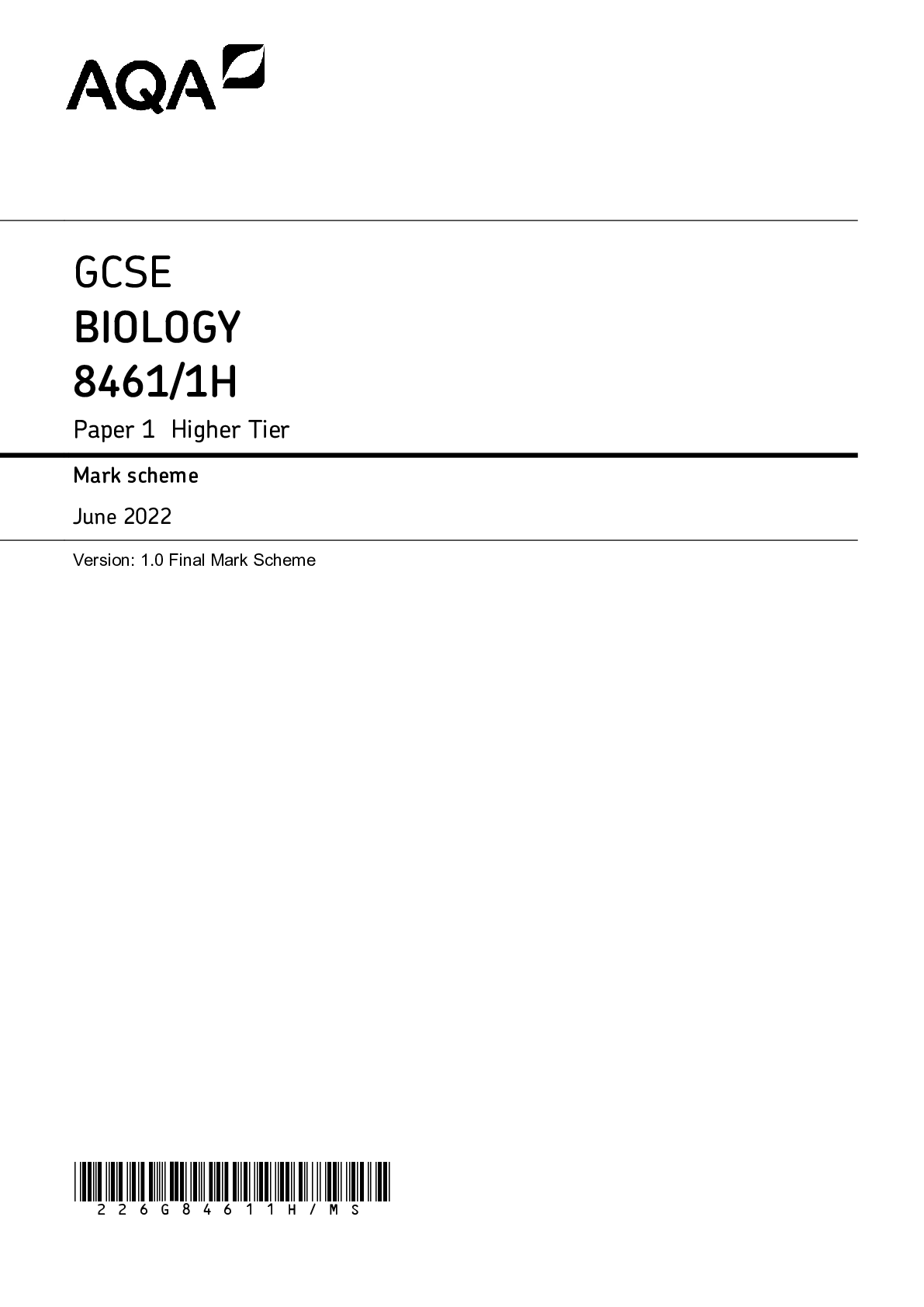
Reviews( 0 )
Document information
Connected school, study & course
About the document
Uploaded On
Jun 14, 2023
Number of pages
30
Written in
Additional information
This document has been written for:
Uploaded
Jun 14, 2023
Downloads
0
Views
25

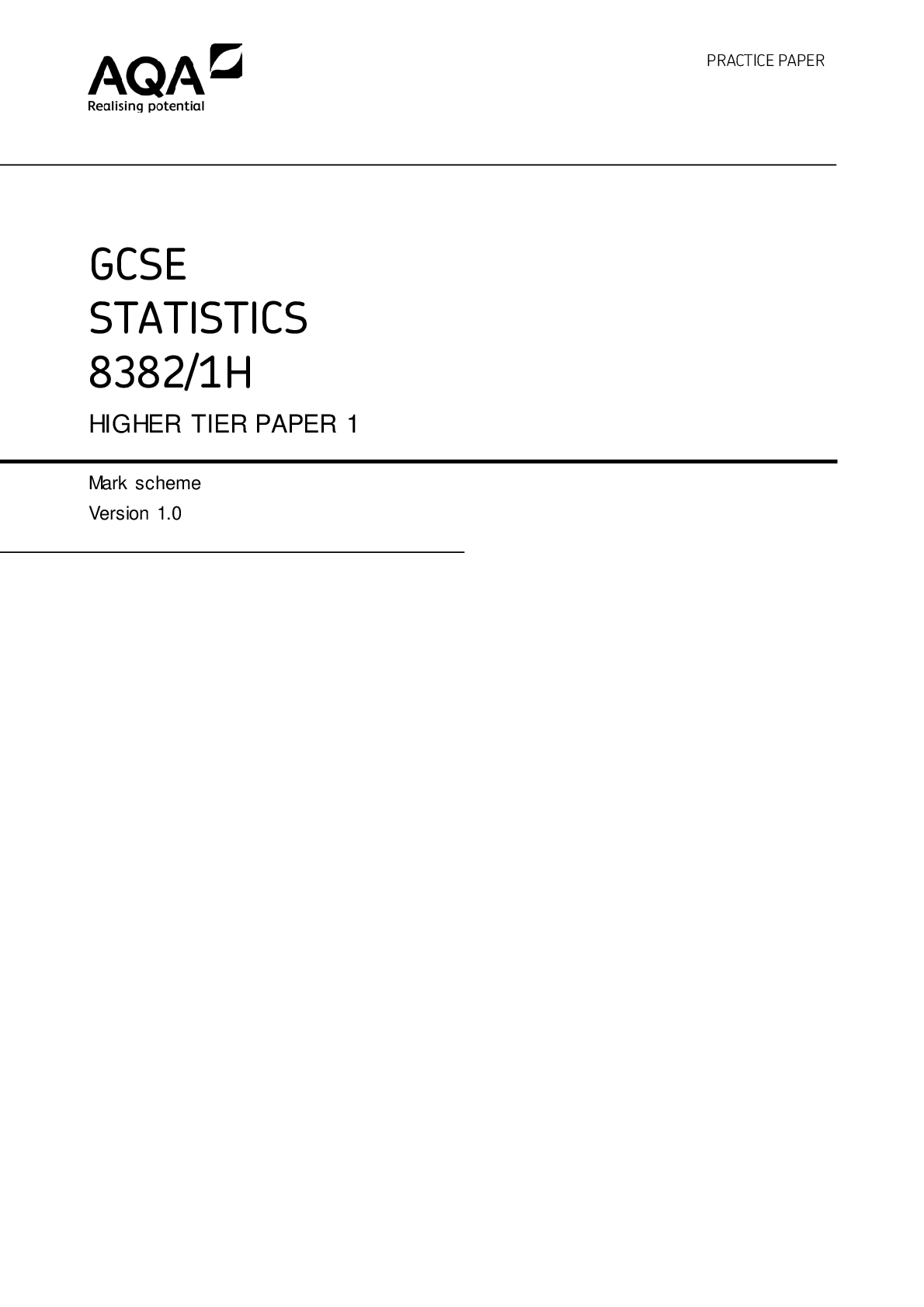
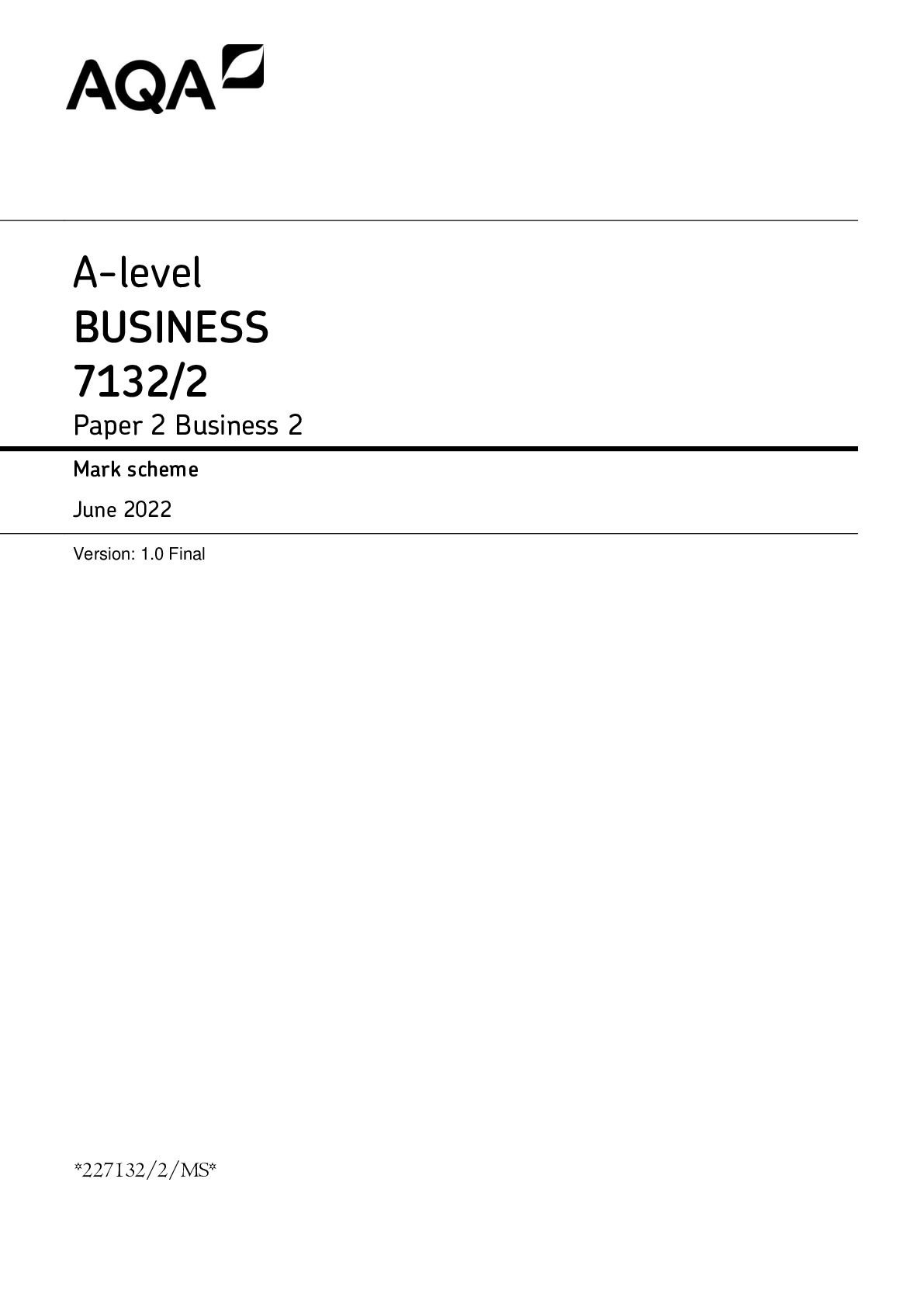
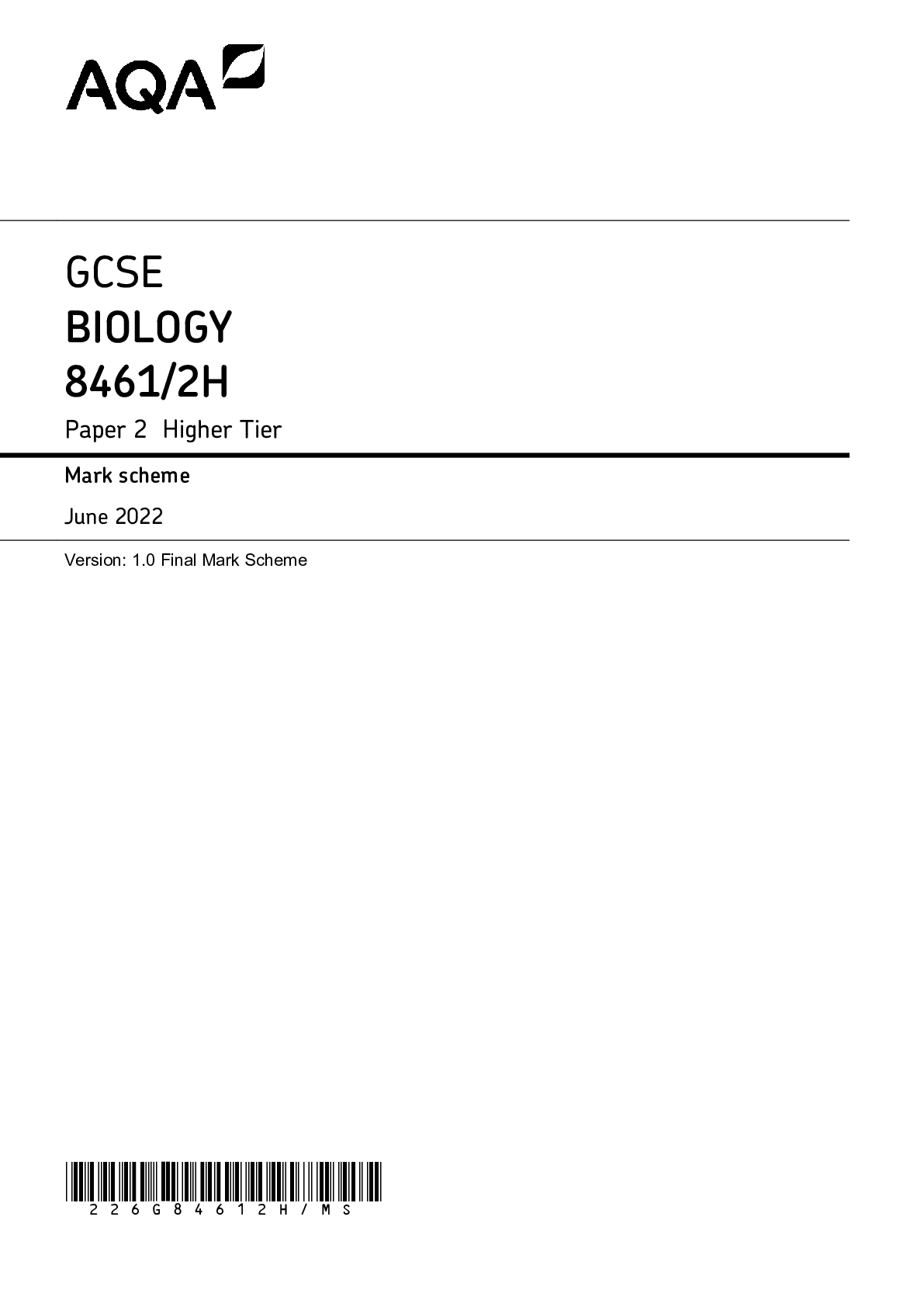
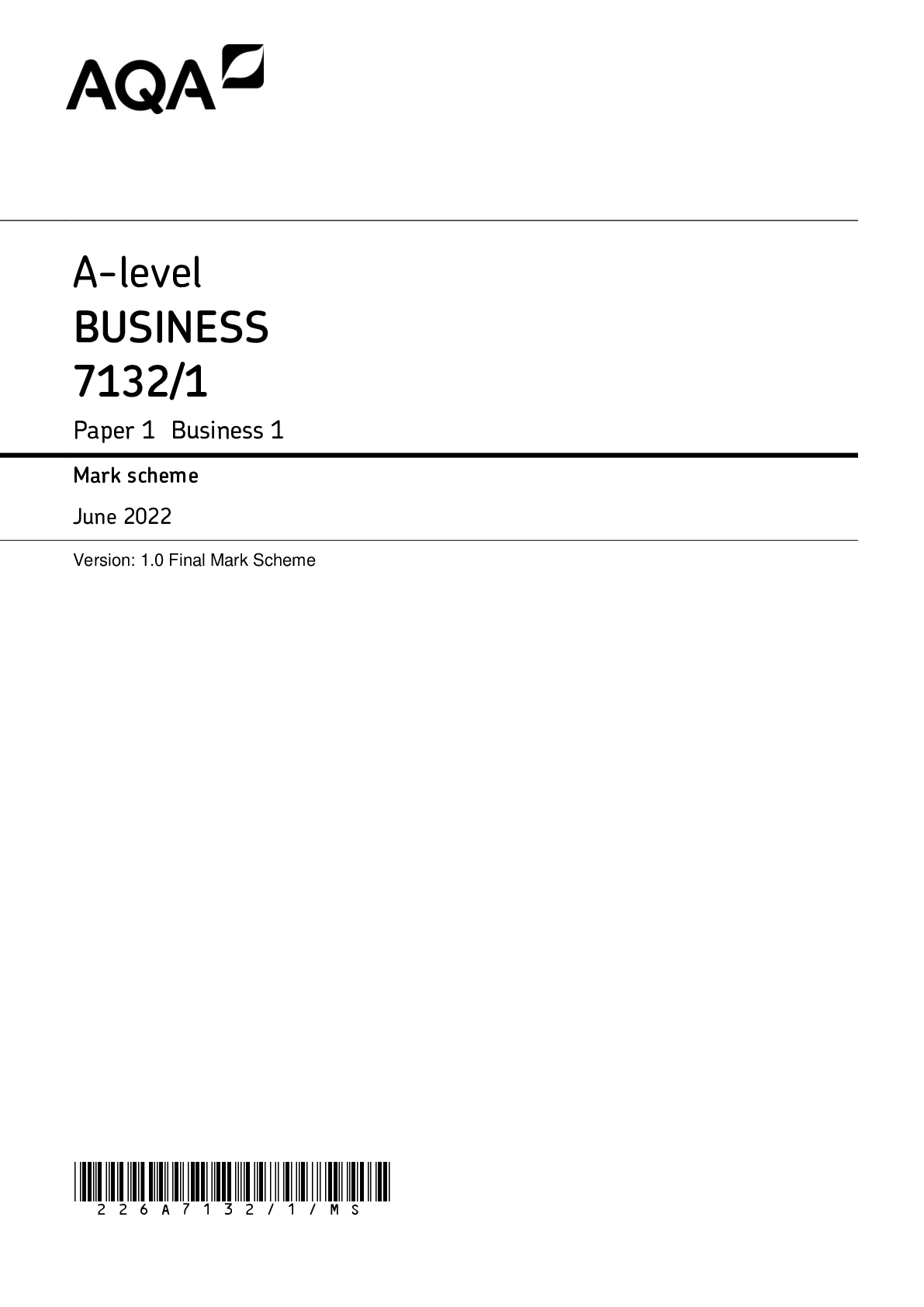


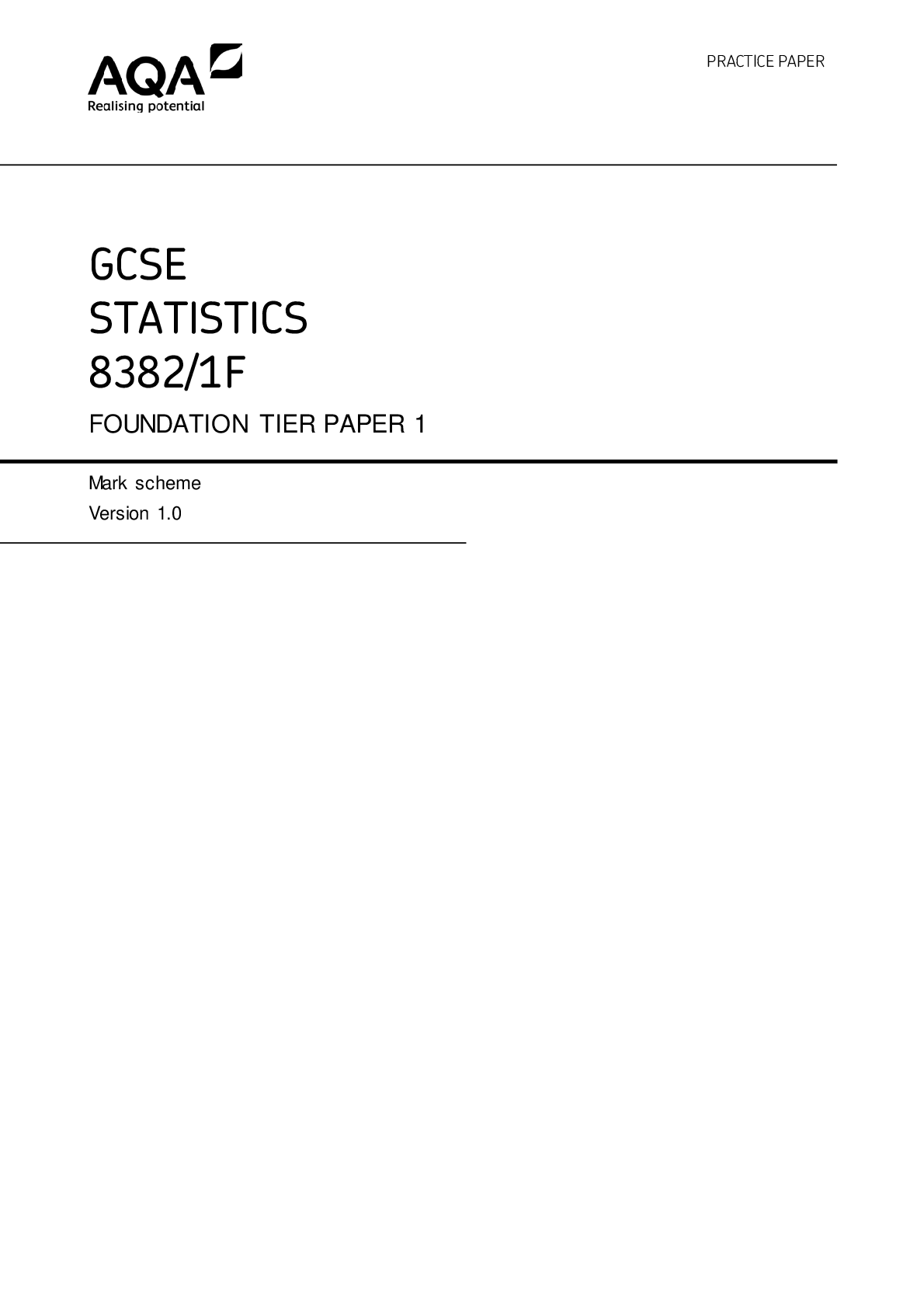
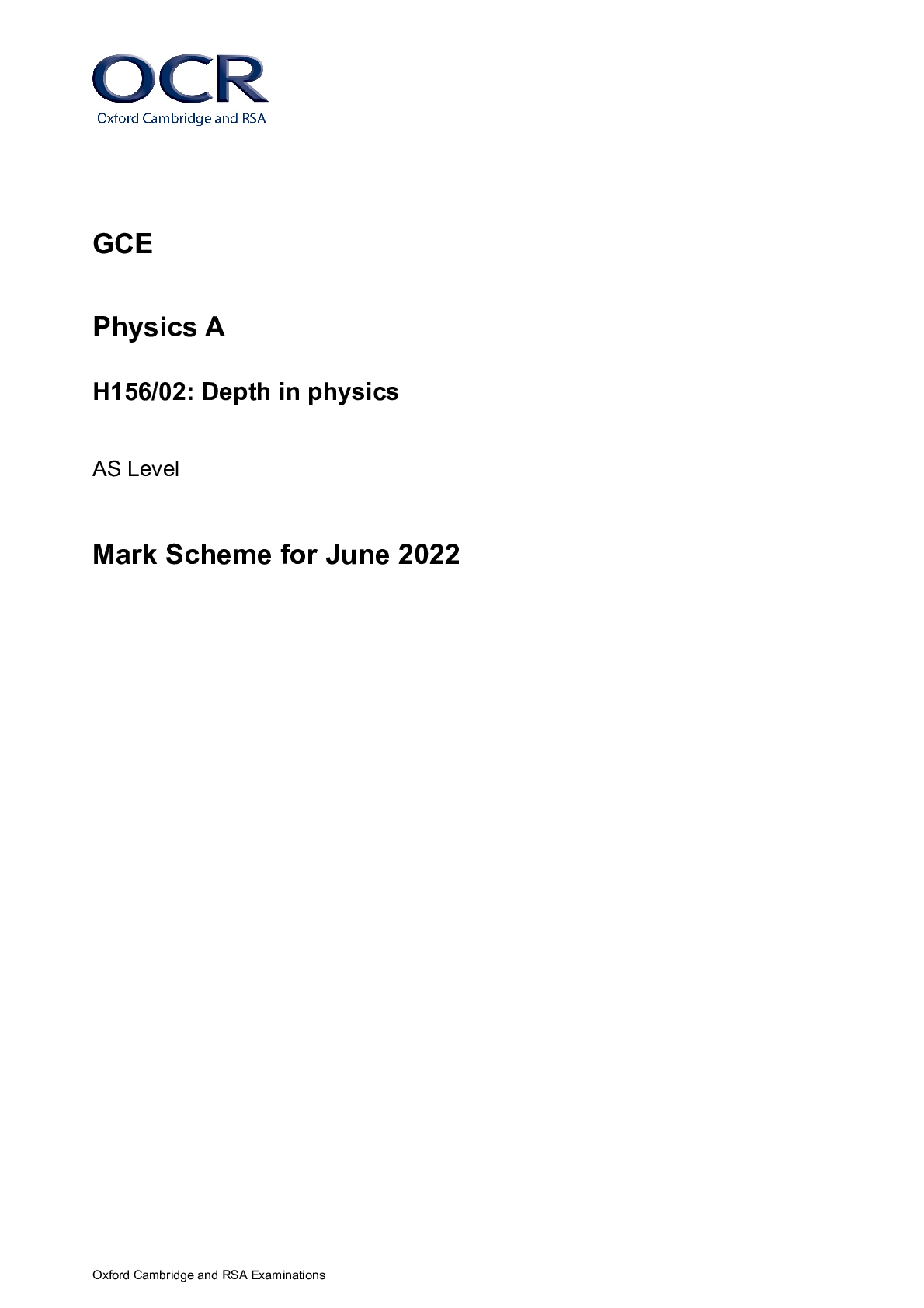
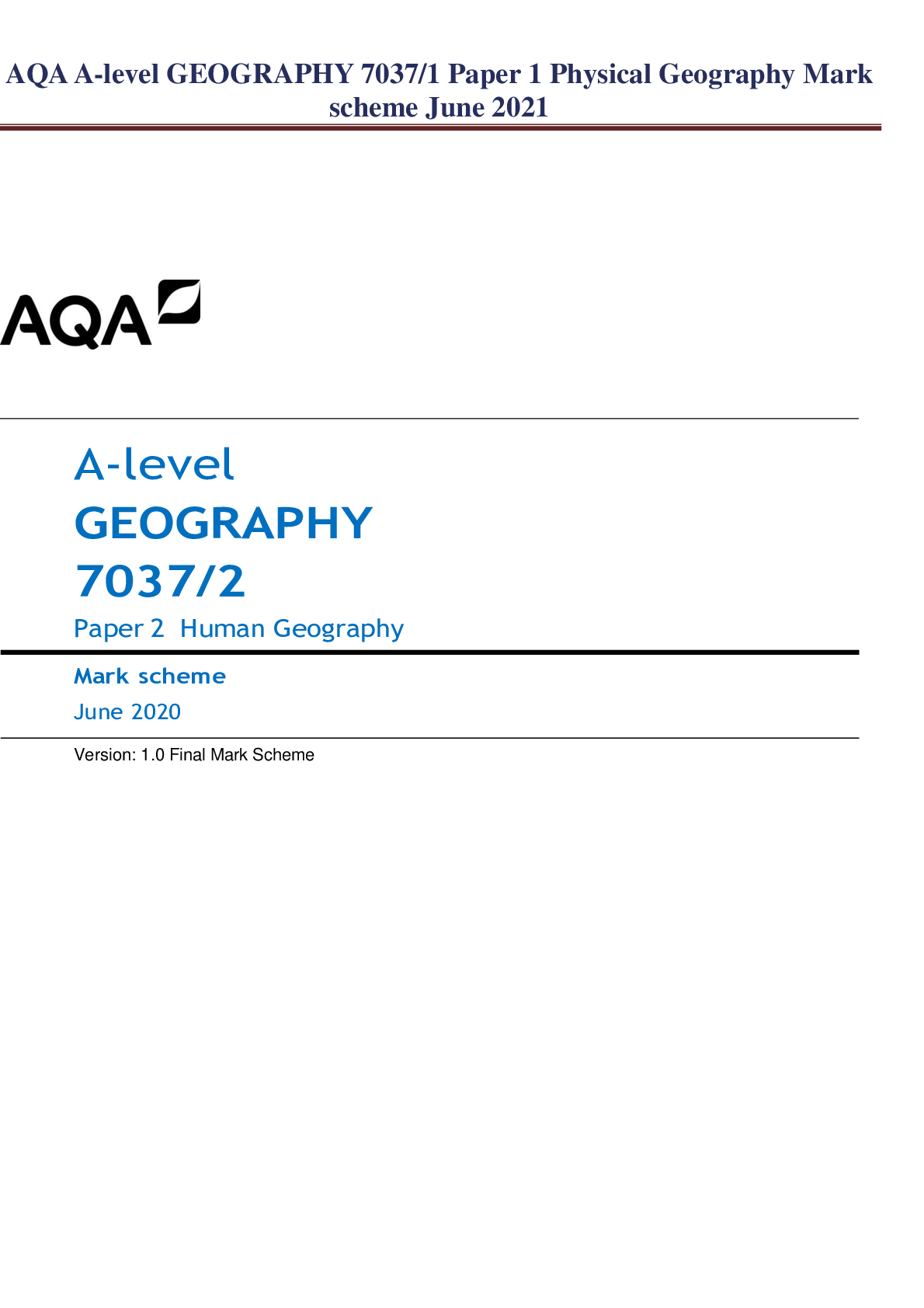
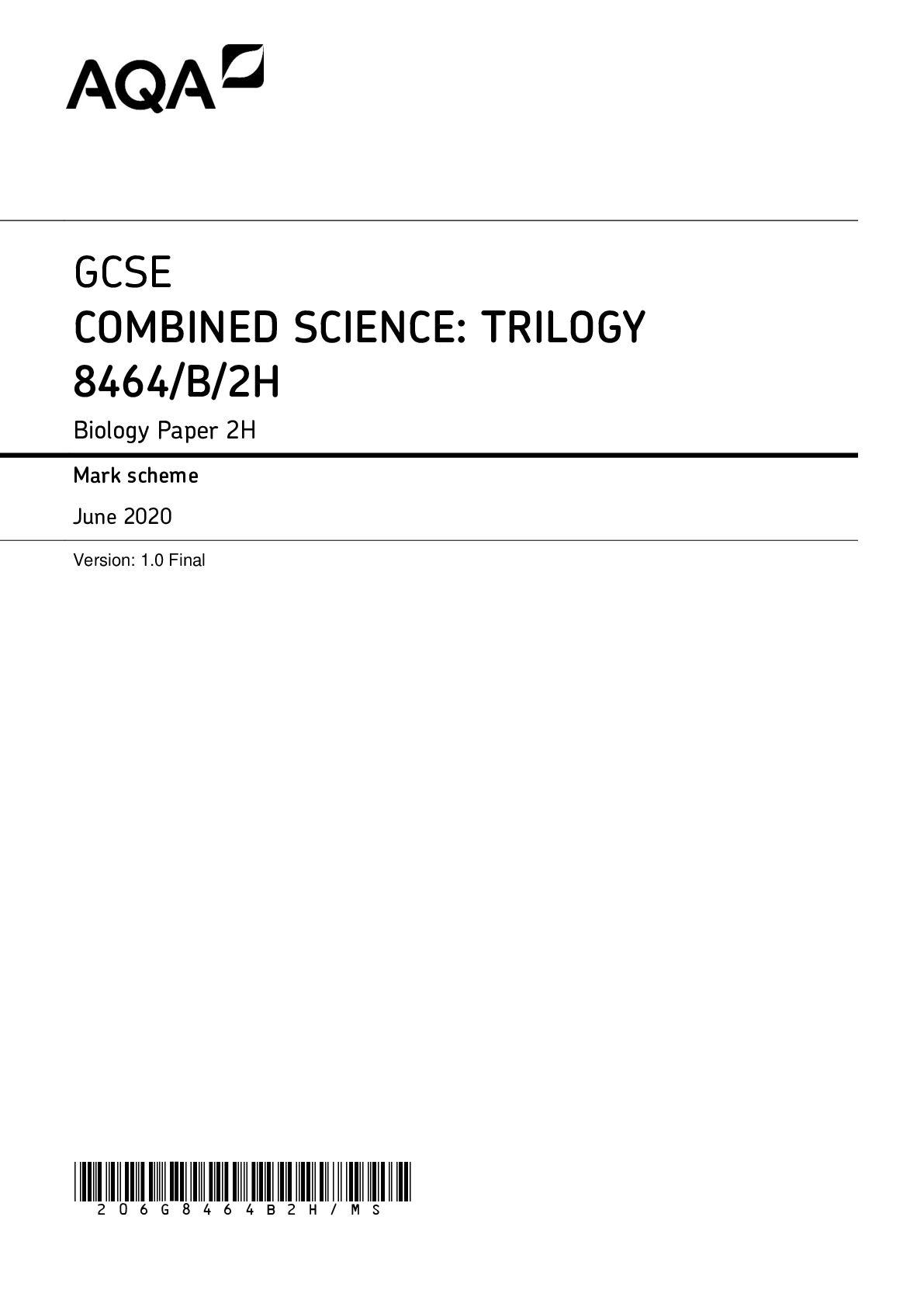
.png)
